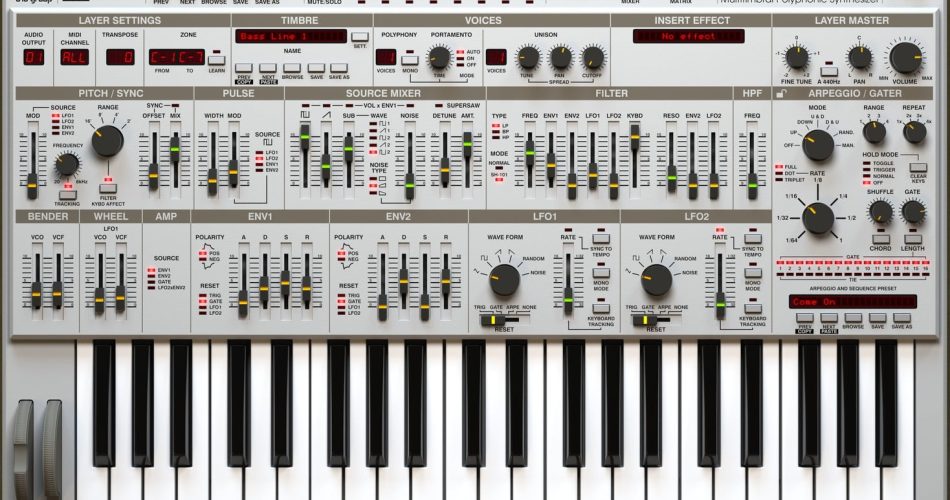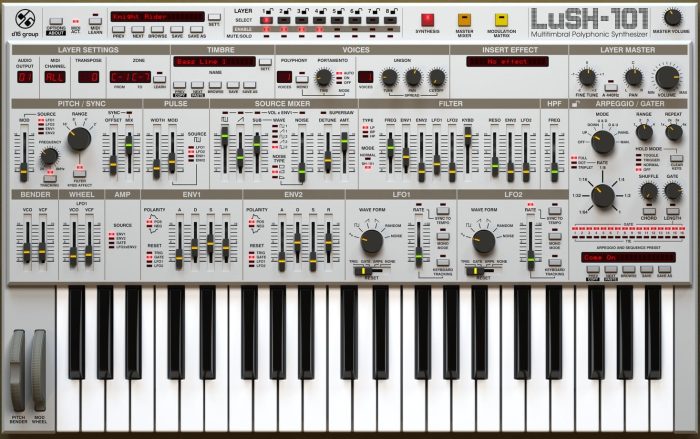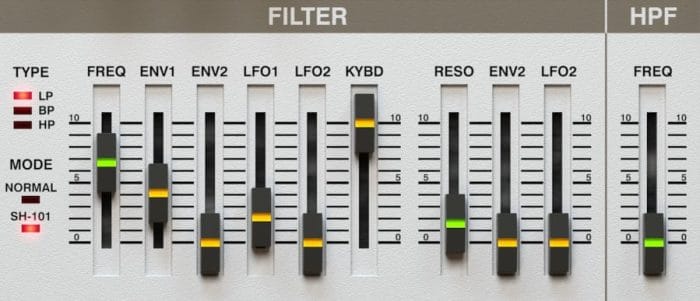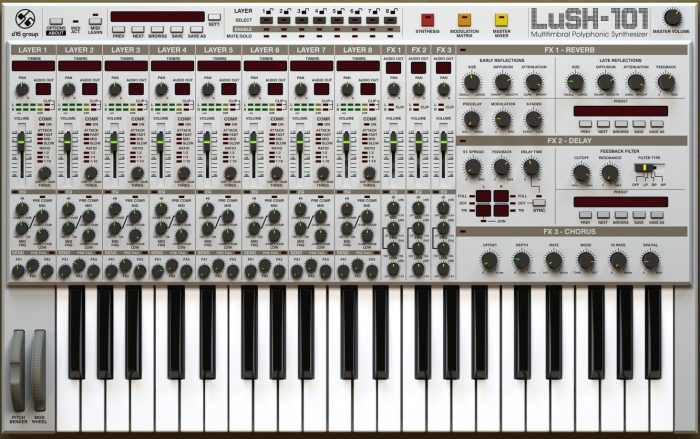D16 Group’s LuSH-101 is probably one of the most anticipated synthesizer plug-in of 2012. Since the initial announcement of the synth (then named Shioiter) over three years ago, it has been a long wait with few progress updates.
With such a long development stage – or rather the general public being in the know so early on – there will always be some hype and (unfounded) high expectations. And sure enough, when LuSH-101 finally arrived the reception was mixed. Some people instantly dismissed it for not emulating the SH-101 faithfully enough, having too many bells and whistles, being a CPU hog, or it just not living up to the “one synth you’ll ever need” tagline. Others have praised LuSH-101’s resemblance to the sounds of the classic Roland synthesizer, or appreciate the additional features included in the plug-in offers.
Though I must admit I have always wanted an MC-202, I am not all that interested in how precise D16 modeled the SH-101. I’ve heard some audio clips comparing the both and it can certainly sound very similar, but LuSH-101 has a lot more to offer than its hardware counterpart.
The multilayer architecture guarantees that both the sound design possibilities and number of unique situations in which LuSH-101 can be used are virtually limitless. Layered sounds can be created simply by assigning the layers to the same MIDI channel; the results can sound as massive as anything imaginable! Assigning the layers to different keyboard zones allows you to create even the most sophisticated splits. Of course, you can always assign the various layers to different MIDI channels for 8-part multitimbral usage. And, virtually any combination of splits, layers, and multitimbrality is possible with just a single instance of LuSH. With each layer working as an independent synthesizer with its own polyphony, parameters, enhanced arpeggiator, and a palette of only the finest insert effects, LuSH-101 can push your creativity to unprecedented levels!
Let’s take a quick look at the specs.
LuSH-101 features
- Multi-layer, 8 independent layers (synths) saw, square/PWM, noise oscillators, A sub osc, supersaw, hardsync, multi-mode and passive hipass filters, 2 LFO’s and envelopes, insert effects, mod matrix, and arpeggiator.
- Mixer panel with 11 output busses (8 layers + 3 fx), compressor and EQ for each, and reverb, chorus, and tempo-syncable delay send fx.
- Includes 1,700 presets, with 5 categories (layer, arp, reverb, delay, and global).
First off, let me say that LuSH-101 requires quite a lot of processing power. Even a single layer sound can take up a considerable amount of CPU – especially when using multiple voices – let alone multiple layer sounds. That said, with careful programming and lowering some settings you can still get decent results on older systems like my good old duo core Pentium.
The sound of LuSH-101 starts with the oscillators. These do not necessarily have an “analog” vibe to my ears, but they do have a pleasant high quality sound about them.
Mixing square (pwm), saw, sub and noise oscillators you have a limited palette, but this can actually help you get creative in a “less is more” kind of way.
The hardsync on the square and saw is achieved by using a hidden oscillator. It has its own sound, I quite like it. The saw can also be stacked to create a supersaw. Not my type of thing really, but I hear it’s pretty sweet.
To the right of the source mixer is the filter section, with a multi-mode (lowpass, bandpass, highpass) resonant filter and a passive highpass, which is said to have a characteristic RC analogue filter. The multi-mode filter has two modes:
- Normal: The overall peak volume of the filter output is constant across the Cutoff frequency and Resonance domain and the filter itself is softer in comparison to SH-101 variant.
- SH-101: More unstable and analogue like with faithful emulation of self-oscillations appearing in SH-101.
I have no idea how faithful this emulation is, but the SH-101 mode sounds quite different from the normal one so make sure you give it a try. Note that some filter stepping is audible, and I am not sure if this is intended but it doesn’t bother me to be honest.
Two envelopes and two LFO’s are available to control various parameters, including things like pitch, pulse width, and cutoff & resonance of the multi-mode filter.
LuSH-101 offers various trigger modes for its envelopes and LFOs, and a special SH-101 mode can be selected from the options panel. The envelopes are also nice and fast, which is demonstrated by the lovely drum sounds this synth can produce.
Moving a bit further to the right of the interface we find the arpeggiator. This features various modes (up, down, up/down, random, etc), a host of tempo/rates, shuffle, chords, gate and tie sequencer, and more. I tend to do everything in my host, but I have to say an arp like this is easy and fun to use.
To spice things up a bit, LuSH-101 also includes some internal insert effects: Chorus, Flanger, String Ensemble, Phaser, Vowel Filter, Distortion, Decimator, and Tremolo. These are simple, solid effects. I especially like the vowel filter and decimator, and the chorus is great for creating lush sounds. You can currently only select one effect at a time, but note that you can set a different effect for each of the 8 layers.
The mixing panel lets you mix all your layers in channel strips. Each channel comes with a compressor, equalizer, and 3 send fx controls for the global reverb, delay and chorus effects. These effects also have dedicated channel strips with an EQ.
On the one hand I like this approach of designing a sound pretty much completely within a synth, on the other hand I feel it is a bit silly to be mixing and applying compression, eq, etc. in a plug-in when you could simply do this in your host software. I’m still a bit divided on the whole thing.
All parameters of LuSH-101’s individual layers (incl. arp, insert fx, mod matrix, etc) can be stored in a timbre preset. The arpeggiator also has its own presets, and so do the reverb and delay in the mixer panel. All settings within an instance of LuSH-101 are stored within a global preset.
The presets browser feels a bit outdated to me. Preset name, author and rating are stored, yet there is no search option or tagging system available. It is basically plain old hierarchical folder browsing. That said, the presets themselves include many wonderful sounds. Lots of quality presets categorized in bass, drum, fx, mono/lead, poly, and tempo based folders.
Alright, a few more bits and bobs before I round up.
LuSH-101 features a plain and simple (boring?) modulation matrix. Source, destination, and amount in a simple panel. Some useful parameters are missing from the destinations list, but more will be added in a future update. A wider range of modulation values would be useful as well.
Talking about updates, the interface has received a good portion of critique from users who either can’t fit the whole thing on their screens, find the huge keys a waste of space, or simply can’t read a thing with those tiny text labels.
Fortunately, the developers are listening and the option to hide the keyboard – which I also though was waste of space, but would you believe I miss it when it’s hidden… – was implemented already, and additional interface sizes are planned for an upcoming update. At a later stage we should even be able to pick our favorite colors for the GUI, just like the early Shioitor teaser shots suggested.
Lastly, when first trying to automate something within your host you will find LuSH-101 doesn’t send out anything by default. As there are too many parameters to assign within the VST/AU spec of 128, you are left to do your own maps. A bit annoying to have to set up, but it’s probably something you are only going to do once and you can use your custom map as a default for subsequent sessions. And again, it has already been announced that improvements for parameter handling, automation and the modulation matrix are planned. LuSH-101 is only going to get better with time.
Check the demo tracks below to listen to the sounds of LuSH-101.
So what do I think?
Format: AU/VST (RTAS and AAX coming)
Price: 149 EUR / $199 USD
Like: High quality, beautiful sound, great presets, layers
Don’t like: High CPU use, presets browser
Verdict: 9/10
Quality comes at a price, and I don’t mean the actual price tag. LuSH-101 requires a lot of processing power. There is no denying that this can be a deal breaker for those with “underpowered” machines.
Looking past this issue (and once again coming to terms with bouncing/freezing in your host), there is also no denying that LuSH-101 is a proper monster synthesizer that is capable of producing high quality sounds. Beyond the SH-101 comparison, LuSH-101 offers so much more than the recreation of a classic. The layering system is really nice, especially for designing dynamic pads.
I am also well impressed with D16 Group’s fast response to user requests/critique. If the first update and the list of upcoming improvements are anything to go by, it looks like LuSH-101 will only get better with time. I hope that there will also be some CPU optimization, or perhaps they could do a lite version with less options, but I will say it again: Quality comes at a price.
Hats off to the D16 team for what they have achieved.
With the version 1.0.1 update, the LuSH-101 demo now allows 30 minutes of testing (and no more annoying pop-up window) so go check it out.








